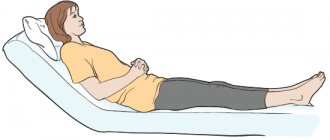October 28, 2021
40 888
20 minutes
Author, editor and medical expert – Klimovich Elina Valerievna.
Acute infections of the upper respiratory tract include inflammation of the nasal cavity, nasopharynx, pharynx and larynx (above the vocal cords) caused by various microorganisms. They all have similar symptoms (despite the variety of pathogens), so in everyday life they are often called “colds,” and doctors use the general term “acute respiratory diseases,” or acute respiratory infections, to refer to them.
Acute respiratory infections are observed all year round. On average, adults get colds 2 to 4 times a year, children get sick more often, 6-9 times - this is normal and necessary for the formation of a healthy immune system2. The peak incidence of acute respiratory tract infections occurs in the autumn-winter-spring period1. The likelihood of colds increases with the first cold snap, in September-October1, when we begin to go out less often and have longer contact with other people, among whom there may be carriers of pathogenic microbes or patients with acute respiratory infections. High humidity and cold outside often cause hypothermia and decreased immunity. Low air humidity in heated rooms leads to drying out of the nasal mucosa, increasing its permeability and susceptibility to infectious agents. Only in May, when the weather improves, does the incidence decline1.
Up to contents
Causes of upper respiratory tract diseases
Despite the similarity of manifestations, acute respiratory infections differ in the nature of their origin. They can be caused by different pathogens.
1.Viruses
They are the culprits of the “cold” in the vast majority of cases3 and then it is called ARVI (acute respiratory viral infection). About 40% of all such infections are associated with rhinoviruses1, which mainly affect the mucous membrane of the nose, nasopharynx and pharynx. They are followed by human coronaviruses, which cause nasopharyngitis, and parainfluenza viruses, which are responsible, among other things, for the development of laryngitis - inflammation of the larynx1. Adenoviruses and respiratory syncytial viruses are less common, as are other almost 200 types of viruses that cause respiratory tract infections4.
In approximately 1-2% of cases, viruses “can contribute to the activation of bacterial microflora”: they penetrate into the cells of the mucosa, cause their death, disrupt the functioning of the ciliated epithelium and the mechanisms of cleansing the respiratory tract, reduce local immunity and thereby create favorable conditions for the development of bacteria. In this case, the inflammation becomes viral-bacterial4.
2.Bacteria
Sometimes acute respiratory infections are initially bacterial in nature. Infectious agents are usually streptococci, pneumococci, Haemophilus influenzae, and Moraxella2. Bacterial infections of the upper respiratory tract often “cling” to young children with undeveloped immunity, elderly people whose bodies are weakened by health problems, and patients with primary and secondary immunodeficiency.
3. Atypical pathogens of acute respiratory infections
This group includes chlamydia, mycoplasma, pneumocystis, legionella and other microorganisms. The respiratory diseases they cause are rare, so we will not dwell on them.
Up to contents
Ear pain
For pain and ringing in the ears, boil 5 whole cloves in 1 tbsp in a water bath. oils Leave the cloves in the oil. 3 drops of warm oil in each ear. For otitis, place a geranium leaf, previously washed and dried, in the ear. After 10-15 minutes the pain should subside.
For tinnitus - 1 tbsp. licorice roots pour 1 tbsp. boiling water Heat for 20 minutes in a water bath. Strain and drink in 4 doses for 10 days, 7 days break + 1 tbsp. brewer's yeast. In the first days with acute laryngitis, you can drink a glass of sweet hot tea, with the addition of 1 tbsp. cognac and warm up under the blanket.
How does infection and development of acute respiratory infections occur?
The source of infection is always people sick with ARVI, who pose the maximum danger to others on the 3-4th day of illness, when the release of viruses into the environment is especially intense5.
The main routes of transmission of respiratory tract infections are airborne droplets and contact4.
- Airborne
Viruses and pathogenic bacteria are contained in the saliva and sputum of the patient. When coughing and sneezing, droplets of nasal mucus and sputum quickly spread in the environment and, together with the air, enter the respiratory system of a healthy person. In confined spaces and public transport, the infection spreads especially quickly, so limiting visits to public places significantly reduces the likelihood of catching ARVI4.
- Contact
The mucus released when the patient sneezes and blows his nose ends up on his hands surrounding household items. Viruses settle on dishes, the patient’s desk, door handles, handrails of public transport, books, and furniture used by an infected person. From these objects, pathogenic microorganisms fall onto the hands of healthy people, and then when they touch the face they are carried into the nose and mouth. It has been proven that contact transmission of viruses is more important than airborne transmission5. Therefore, frequent hand washing can be called one of the main ways to prevent respiratory tract infections5.
How does the disease develop? Once on the mucous membrane of the nasal cavity, viruses invade its cells and begin to multiply intensively. Their number reaches a critical level within 1-3 days (incubation period), after which the first symptoms of the disease begin to appear. In this list:
- Rhinitis is inflammation of the mucous membrane of the nasal cavity.
- Pharyngitis is an inflammation of the pharynx, soft palate, uvula and lymphoid tissue of the pharynx.
- Epiglottitis is an inflammation of the upper part of the larynx and epiglottis, which closes the entrance to the trachea during swallowing.
- Laryngitis is inflammation of the larynx.
Most often, colds are associated with viral nasopharyngitis - a combined inflammation of the mucous membrane of the nasal cavity and pharynx. If the disease is mild and does not lead to complications, doctors usually write “ARVI” or “acute upper respiratory tract infection” in the patient’s card, without specifying the localization of the inflammatory process2,3.
Up to contents
Impaired sense of smell (hyposmia)
Depends both on local causes and on damage to the central nervous system (CNS). There are respiratory and essential disorders of smell. Hyperosmia (painful heightened sense of smell), cacosmia (olfactory hallucinations), parosmia (perverted sense of smell) and anosmia (lack of smell). Respiratory anosmia is caused by the fact that the air stream does not enter the olfactory gap, which can be closed due to a sharp curvature of the nasal septum, polyps, swelling and tumor.
When the cause is eliminated, the olfactory function is restored. And if a violation of the sense of smell occurs as a result of damage to the receptors of the olfactory nerve, which occurs after the flu, with a skull injury, tumors, it is almost impossible to restore the lost function.
Symptoms of acute respiratory infections
The clinical picture of all colds consists of the same general and local manifestations in varying degrees of severity and combinations.
General symptoms
Their severity depends on the type of pathogen and can vary from mild malaise to severe intoxication, accompanied by disruption of the functioning of internal organs and clouding of consciousness.
| Fever | It can be especially pronounced in young children, in whom the symptoms of intoxication prevail over the local manifestations of a cold5. Fever may be absent in mild cases of the disease, as well as in weakened patients and elderly people1. |
| Aches and pains in muscles and joints | In some patients, these sensations are limited to the appearance of a feeling of weakness; in others, the body aches are so strong that they do not allow them to sleep and force them to take painkillers. |
| Headache | It is more typical for influenza, but can also appear with other viral diseases, especially when they are severe1 and the temperature rises to 40 0C or higher. In these cases, the headache may be accompanied by nausea and unrelieved vomiting associated with irritation of the meninges1. |
| Gastrointestinal discomfort | Decreased appetite, nausea and vomiting, intestinal colic and diarrhea, as manifestations of a viral infection of the upper respiratory tract, are more common in children5. Sometimes they accompany streptococcal lesions5. |
Local manifestations of acute respiratory infections
Their diversity is determined by the level of damage to the respiratory tract.
| Runny nose | It begins with the appearance of itching, burning, nasal congestion, sneezing and copious mucous discharge from the nasal passages. As the process develops and bacterial microflora joins, the nasal mucus acquires a yellowish-greenish tint, there is less of it, and it begins to dry out, forming crusts in the nose. This reduces nasal congestion. |
| Sore and sore throat | They are associated with inflammation and dryness of the pharyngeal mucosa, intensify during swallowing and decrease slightly after warm drinking. The mucous membrane of the pharynx, palatine arches, uvula and tonsils look red and swollen. Enlarged lymphoid follicles are visible on the posterior wall of the pharynx. |
| Cough | One of the causes of cough during acute respiratory infection is the flow of mucus from the nose and nasopharynx into the respiratory tract. The second reason is associated with irritation of the receptors of the inflamed pharynx - in this case, the cough appears approximately on the 2-3rd day of the disease, more often it is dry, hacking, and even vomiting. A barking cough and hoarseness on the 4-5th day of illness indicate involvement of the larynx in the pathological process and the development of laryngitis. Children may develop false croup, in which attacks of convulsive coughing are accompanied by difficult, noisy breaths, and sometimes even periods of cessation of breathing5. The condition worsens at night, which is associated with an increase in mucus production and impaired sputum discharge at this time of day5. |
| Sputum | In the first days of the disease, the cough is always dry and painful. The appearance of sputum in the following days alleviates the suffering somewhat. When the upper parts of the respiratory tract are affected, it is not abundant. Its mucous nature indicates the viral nature of the disease; bacterial infections of the respiratory tract are accompanied by the release of purulent sputum. |
Additional symptoms
Along with the general manifestations typical of all diseases of the upper respiratory tract, in some cases specific symptoms are observed.
Thus, when infected with adenoviruses, signs of conjunctivitis appear; children often have abdominal pain associated with inflammation of the intra-abdominal lymph nodes5.
Respiratory syncytial virus tends to affect not only the upper, but also the lower parts of the respiratory tract, quickly causing the development of bronchitis and bronchiolitis1.
Bad breath is often a symptom of a bacterial respiratory tract infection. It is associated with the appearance of pus in the oropharynx - a product of inflammation and the activity of pathogenic microorganisms.
Up to contents
STREPTOCOCCAL TONSILLITIS AND PHARINGITIS
Classification
Pharyngitis
- this is an acute inflammation of the mucous membrane of the pharynx, usually of viral, less often bacterial, origin.
Tonsillitis
- acute inflammation of the tonsils, usually as a result of streptococcal, less often viral, infection.
Streptococcal tonsillitis
(angina) - tonsillitis or pharyngitis caused by GABHS (
S.pyogenes
).
Under recurrent streptococcal tonsillitis
one should understand multiple episodes of acute tonsillitis over several months with positive results of bacteriological and/or rapid diagnostic methods of GABHS, negative results of studies between episodes of the disease, and an increase in titers of antistreptococcal antibodies after each case of the disease.
Streptococcal tonsillitis
dangerous due to the development of complications, which can be divided into
early
(purulent) complications developing on the 4-6th day from the onset of the disease (otitis, sinusitis, peritonsillar abscess, cervical lymphadenitis), and
late
(non-purulent) complications developing in the convalescence stage - 8 -10th day from the onset of the disease (post-streptococcal glomerulonephritis, toxic shock) or 2-3 weeks after relief of symptoms (rheumatic fever).
Main pathogens
Among the bacterial pathogens of acute tonsillitis
and
pharyngitis,
GABHS is of greatest importance (15-30% of cases).
Less commonly, acute tonsillitis is caused by group C and G streptococci, A.haemolyticum, N.gonorrhoeae, C.diphtheriae
(diphtheria), anaerobes and spirochetes (Simanovsky-Plaut-Vincent angina), rarely - mycoplasma and chlamydia. The cause of viral acute pharyngitis and, to a lesser extent, tonsillitis can be adenoviruses, rhinovirus, coronavirus, influenza and parainfluenza viruses, Epstein-Barr virus, Coxsackie virus, etc.
It is difficult to distinguish viral pharyngitis from bacterial pharyngitis only based on physical examination data; therefore, rapid methods for detecting the GABHS antigen and bacteriological examination are important for diagnosis.
Choice of antimicrobials
The use of antimicrobial therapy is justified only for bacterial etiology of acute tonsillitis
, most often streptococcal (GABHS). The goal of antibacterial therapy is to eradicate GABHS, which not only leads to a reduction in symptoms of infection, but also prevents the development of complications.
Antibacterial therapy can be started before receiving the results of a bacteriological study if there are epidemiological and clinical data indicating a streptococcal etiology of acute tonsillitis
.
GABHS are highly sensitive to β-lactams (penicillins and cephalosporins). The latter remain the only class of AMPs to which these microorganisms have not developed resistance. The main problem is resistance to macrolides, which in Russia is 13-17%, while the M-resistance phenotype, characterized by resistance to macrolides and sensitivity to lincosamides (lincomycin and clindamycin), has become widespread.
Tetracyclines, sulfonamides and co-trimoxazole do not eradicate GABHS and therefore should not be used for the treatment of acute streptococcal tonsillitis
caused even by strains sensitive to them
in vitro
.
Considering the widespread high sensitivity of GABHS to β-lactam antibiotics, the drug of choice for the treatment of acute streptococcal tonsillitis
is penicillins (phenoxymethylpenicillin), alternative drugs are oral cephalosporins of the first generation (cefadroxil, cephalexin) and aminopenicillins (amoxicillin). The advantages of penicillin for tonsillopharyngitis are: high clinical effectiveness, which has not changed over the entire period of its use; narrow spectrum of activity, which reduces “environmental pressure” on normal microflora; low cost (10-20% of the cost of oral cephalosporins); well tolerated in patients without allergies to β-lactam antibiotics.
If the patient has received AMPs in the previous month, amoxicillin/clavulanate is used as the drug of choice. Alternative drugs have a wider spectrum of antibacterial activity and can affect the normal microflora of the body.
It is advisable to prescribe benzathine benzylpenicillin if there are doubts about the patient’s diligence, a history of rheumatic fever in the patient or close relatives, unfavorable social conditions, outbreaks of A-streptococcal infection in preschool institutions, schools, boarding schools, colleges, military units, etc.
In severe cases of tonsillitis (high body temperature, intoxication, serious condition of the patient), benzylpenicillin can be used intramuscularly for 2-3 days, followed by switching to phenoxymethylpenicillin orally for up to 10 days.
In patients allergic to β-lactam antibiotics, macrolides (azithromycin, clarithromycin, midecamycin, spiramycin, etc.) or lincosamides should be used.
When treating acute streptococcal tonsillitis, it must be borne in mind that eradication of GABHS requires a 10-day course of antimicrobial therapy (the exception is azithromycin, which is used for 5 days) (Table 3).
Table 3. Antibacterial therapy for acute and recurrent streptococcal tonsillitis
| Drugs | Dosage regimen (adults) | Features of application |
| Drugs of choice | ||
| Phenoxymethylpenicillin | 0.25 g every 8-12 hours | Orally, 1 hour before meals, for 10 days |
| Benzylpenicillin | 500 thousand units every 8-12 hours | V/m |
| Benzathine benzylpenicillin | 2.4 million units | IM, once |
| Alternative drugs | ||
| Amoxicillin | 0.5 g every 8 hours | Orally, regardless of food intake, for 10 days |
| Amoxicillin/clavulanate | 0.625 g every 8 hours | Orally, at the beginning of meals, for 10 days |
| Cephalexin | 0.5 g every 6 hours | Orally, 1 hour before meals, for 10 days |
| Cefadroxil | 0.5 g every 12 hours | Orally, regardless of food intake, for 10 days |
| If you are allergic to β-lactam antibiotics | ||
| Erythromycin | 0.25-0.5 g every 6 hours | Orally, 1 hour before meals, for 10 days |
| Azithromycin | 0.5 g 1 time per day | Orally, 1 hour before meals, for 5 days |
| Spiramycin | 3 million IU every 12 hours | Orally, regardless of food intake, for 10 days |
| Clarithromycin | 0.5 g every 12 hours | Orally, regardless of food intake, for 10 days |
| Roxithromycin | 0.15 g every 12 hours | Orally, 15 minutes before meals, for 10 days |
| Midecamycin | 0.4 g every 8 hours | Orally, before meals, for 10 days |
| Lincomycin | 0.5 g every 6 hours | Orally, 1-2 hours before meals, for 10 days |
| Clindamycin | 0.15 g every 6 hours | Orally, 1-2 hours before meals, for 10 days |
Recommended for the treatment of recurrent streptococcal tonsillitis.
Diagnostics
Diagnosis of acute respiratory infections is based mainly on clinical symptoms of inflammation of various parts of the respiratory tract and the results of a medical examination. Given the predominantly mild course of the cold, no additional research is required. Virological diagnosis is usually not carried out, the nature of the pathogen remains unspecified - acute respiratory tract infections do not require specific treatment4,5.
Bacteriological analysis of throat swabs and rapid tests for group A beta-hemolytic streptococcus make it possible to differentiate common viral sore throats and pharyngitis from dangerous bacterial diseases that require immediate antibiotic therapy4,5. Bacteriological examination is also indicated in case of complications development and lack of effect from the antibiotics used4.
Up to contents
PLEURAL EMPYEMA
Empyema of the pleura
(purulent pleurisy, pyothorax) is a pathological process characterized by the accumulation of pus in the pleural cavity and is an unfavorable variant of the course of exudative pleural effusion (pleurisy) of various origins.
Main pathogens
The composition of pathogens that are isolated during pleural empyema (Table 6) largely depends on the characteristics of pathogenesis. Thus, the main microorganisms in empyema associated with pneumonia (with or without lung abscess) are anaerobes. In contrast, the spectrum of pathogens after surgery is predominantly aerobic gram-negative bacteria or S. aureus
. In 5-20% of cases, the exudate turns out to be sterile.
Table 6. Etiology of pleural empyema
| Pathogen | Detection rate, % |
| Anaerobes | 19 |
| Gram-negative aerobes | 15 |
| S. aureus | 15 |
| S. pneumoniae | 7 |
| S.pyogenes | 1 |
| Mixed infection | 25 |
| Pathogen not detected | 28 |
Choice of antimicrobials
In most cases, it is possible to carry out targeted antibacterial therapy taking into account data from microbiological examination of the contents of the pleural cavity.
If the purulent effusion turns out to be sterile, AMPs or their combinations that are active against anaerobes and aerobic gram-negative enterobacteria should be used: inhibitor-protected penicillins; III-IV generation cephalosporins or fluoroquinolones + metronidazole; lincosamides + aminoglycosides of the II-III generation, cefoperazone/sulbactam.
The development of pleural empyema as a complication after surgery is often associated with S.aureus
. Depending on sensitivity, ghbvtytys may be oxacillin, vancomycin, cefazolin, linezolid.
The main route of administration of AMPs for pleural empyema is intravenous. The duration of antibiotic therapy is determined individually.
Possible complications
Even though a cold is usually mild and goes away within 7-10 days, it can cause complications.
Complications associated with activation of bacterial microflora 1
| Acute purulent rhinosinusitis | or inflammation of the nose and paranasal sinuses. This is the most common complication of ARVI. You can suspect its development if the symptoms of a cold do not disappear after 7-10 days, nasal congestion persists, the temperature rises again, heaviness in the head in the sinus area and headache appear. |
| Acute otitis media | or inflammation of the middle ear. Its development is indicated by the appearance of shooting pain and a feeling of stuffiness in the ear. |
| Acute bronchitis | its bacterial form is accompanied by the release of purulent sputum and occurs more often in people with chronic problems of the respiratory system. |
| Pneumonia | one of the most dangerous complications of respiratory diseases. It’s worth thinking about if the fever lasts longer than 10 days, cough, general weakness and sweating persist. |
Bacterial complications of respiratory tract infections require treatment with antibiotics, so you should always consult a doctor if symptoms appear. In case of mild cases, colds in adults can be treated independently, without resorting to medical help. ARI in children, due to the high risk of complications, requires consultation with a pediatrician.
Up to contents
Ear noise
Often found in various ear diseases. It can manifest itself in diseases of the organ of hearing, as well as in central hearing impairment. Another cause of ear noise is a vascular factor. Murmurs can appear with atherosclerosis and high blood pressure, aneurysms of large vessels. Enlarged lymph nodes of the head and neck
It happens with inflammatory and tumor processes in the ENT organs, as well as with blood diseases, lymphogranulomatosis. Enlarged, painful single mobile lymph nodes behind the angle of the lower jaw are a valuable diagnostic sign of chronic tonsillitis.
Providing first aid at home
Treatment of upper respiratory tract infections
All methods of treating colds can be divided into non-drug and medicinal.
Non-drug methods
Mode
In most cases, treatment of acute respiratory infections does not imply hospitalization, but compliance with the home regime is always mandatory. Moreover, it is better to spend the first days of the disease, while the fever persists, in bed. This is especially important for children, but adults should not ignore this rule either.
Hygiene measures
It is necessary to maintain a room temperature of about 200 C and a humidity of about 50-70%, which is achieved through wet cleaning and frequent ventilation of the room2. Heat and dry air “dry” the airways, intensify coughing and promote bacterial infection. Cold and excessive humidity in the room lead to hypothermia and aggravate the course of acute respiratory infections.
To purify the air from viruses and bacteria, it is recommended to use ionizers, bactericidal and ultraviolet lamps2. They help reduce the risk of bacterial complications during treatment and also protect family members and guests from respiratory tract infections.
Diet
The diet should be chemically and mechanically gentle, aimed at fully satisfying the body's needs for nutrients, vitamins and microelements. It is better to exclude spices, spices and smoked foods, limit salt and sugar intake, reduce the amount of sour and carbohydrate foods: sweets, flour products, potatoes, legumes and corn. You should not get carried away with raw vegetables and fruits; it is optimal to consume them boiled and baked. Meat – mostly minced and in small quantities. Fermented milk products, various fruit drinks, jelly, and puddings are useful.
Drinking regime
Compliance with the drinking regime is a fundamental principle in the treatment of diseases of the upper respiratory tract4. Fever is accompanied by increased sweating. To prevent dehydration and maintain optimal moisture in the mucous membranes, you need to consume a sufficient amount of fluid (at least 30 ml per 1 kg of body weight per day)4. You can drink plain clean water, still mineral water, fruit drinks, compotes without sugar, cold green or herbal tea. It is advisable to avoid coffee, cocoa, and carbonated sweet drinks: they irritate the mucous membranes.
Nasal rinsing and gargling
Liquid nasal mucus has a protective function. It prevents the penetration of microbes into the mucous membrane, moisturizes and cleanses it. Nasal rinsing is aimed at removing dried mucus and maintaining a liquid state of nasal secretions4. As rinsing solutions, you can use regular saline solution and special preparations based on sea water.
Gargling helps cleanse the mucous membrane of the oropharynx, eliminate soreness, burning and pain in the throat, and reduce cough4. For rinsing, decoctions and infusions of medicinal herbs that have an anti-inflammatory effect are suitable4.
Medication methods
Methods of drug therapy for ENT diseases, in particular respiratory tract infections, can be divided into general and local.
General treatment
It includes etiotropic therapy: antiviral and antibacterial, implying the destruction of pathogens, as well as symptomatic therapy aimed at combating the manifestations of the disease.
Antiviral and antibacterial therapy
Antiviral drugs for ARVI are less effective than for influenza1,5, so the advisability of their use is questionable.
Systemic antibiotics (taken orally, by injection and infusion) are indicated only in cases of proven bacterial infection, in particular with the development of bacterial complications such as acute tonsillitis, otitis media, sinusitis1,5.
Up to contents
EPIGLOTTITIS
Acute epiglottitis
is a rapidly progressive inflammation of the epiglottis and surrounding tissues, which can lead to sudden complete obstruction of the airway. Epiglottitis most often occurs in boys 2-4 years old and is accompanied by sore throat, elevated body temperature, dysphonia and dysphagia, but there are practically no visible changes when examining the pharynx.
Main pathogens
The main causative agent of epiglottitis is H. influenzae
type B, which can be isolated during bacteriological examination of smears from the epiglottis and blood.
In adult patients, the disease can be caused by gram-positive pathogens (viridans streptococci, S. pneumoniae, S. pyogenes
and
S. aureus
) and anaerobes.
Choice of antimicrobials
The primary goal is to maintain patency of the airway through intubation with an endotracheal or nasotracheal tube or tracheostomy.
Antibacterial therapy should be aimed at eradicating Haemophilus influenzae; when choosing antimicrobial agents, possible resistance to ampicillin in H. influenzae
. Therefore, the drugs of choice for the treatment of epiglottitis are cephalosporins II (cefuroxime), III (cefotaxime or ceftriaxone), or IV generations (cefepime), a combination of ampicillin with chloramphenicol, or inhibitor-protected penicillins (amoxicillin/clavulanate, ampicillin/sulbactam). Given the severity of the condition and the risk of sudden development of DP obstruction, drugs are prescribed intravenously.
The duration of the course of antibiotic therapy should be 7-10 days. After the patient’s condition improves and extubation, they switch to administering AMPs intramuscularly or taking the drug orally.
Antibacterial prophylaxis with rifampicin at a dose of 20 mg/kg once a day for 4 days (but not more than 0.6 g/day) should be carried out for children under 4 years of age who have been in close contact with a patient with epiglottitis (Table 4 ). It should be noted that the introduction of H. influenzae
type B reduced the incidence in children under 5 years of age by 20 times.
Table 4. Antibacterial therapy for epiglottitis
| A drug | Dosage regimen (adults, i.v.) |
| Cefuroxime | 0.75-1.5 g every 8 hours |
| Cefotaxime | 1-2 g every 6-8 hours |
| Ceftriaxone | 1-2 g every 12-24 hours |
| Cefepime | 2 g every 12 hours |
| Ampicillin + chloramphenicol | 1-2 g every 4-6 hours + 1 g every 6 hours |
| Amoxicillin/clavulanate | 1.2 g every 8 hours |
| Ampicillin/sulbactam | 1.5-3.0 g every 6-8 hours |
Symptomatic treatment
It is aimed at combating the symptoms of the disease - manifestations of respiratory tract infection, such as fever, nasal congestion, sore throat and cough.
- Antipyretic drugs
With uncomplicated acute respiratory infections in adults, the temperature rarely exceeds 380 C. According to WHO recommendations, treatment of fever with antipyretic drugs in adults should be started only if the fever has reached 38.50 C10. For diseases of the heart, lungs, nervous system and poor tolerance to high temperatures, you can take medications earlier.
Children with acute respiratory infections have a fever more often than adults, but you should not abuse antipyretic drugs.
Based on generally accepted rules, a child’s temperature should be brought down5,10 in the following cases:
- if it rose above 390 C;
- if the child is less than 3 months old and the temperature has reached 380C or higher;
- if a child does not tolerate heat well, he is predisposed to seizures, heart defects, arrhythmias and diseases of the nervous system.
Do not try to reduce the temperature to normal values; it is enough to reduce it by 10C5.10.
Important! In any case, if your child’s temperature rises, you should consult a doctor and strictly follow his recommendations.
- Vasoconstrictor nasal drops
Vasoconstrictors - decongestants - can be used to relieve nasal congestion to relieve nasal breathing and reduce the risk of developing sinusitis. However, it is better to limit their use in order to avoid the addictive effect and the development of drug-induced rhinitis4,5.
- Remedies for sore throat
There are special solutions for gargling, such as HEXORAL® SOLUTION5.
The main active ingredient of HEXORAL® SOLUTION is the antiseptic hexetidine, which has antiseptic and antifungal effects6. It is active against some influenza A viruses, respiratory syncytial virus and herpes simplex virus type 1, which affect the respiratory tract, gram-positive bacteria, which include beta-hemolytic streptococcus, and Candida fungi, which are activated by decreased immunity and the use of antibiotics6.
The analgesic effect of hexethidine helps to cope with sore throat and relieve sore throat. Due to its high safety profile, the drug can be used not only in adults, but also in children over 3 years of age.
HEXORAL® in AEROSOL form is especially convenient for children who do not know how to gargle. HEXORAL®AEROSOL for the whole family is equipped with several nozzles of different colors, which allows it to be used by several patients.
To soothe the throat during the day, adults and children over 4 years old can use HEXORAL® TABS, and adults and children over 6 years old can use TABS CLASSIC. Absorbable tablets HEXORAL® TABS contain not only a broad-spectrum antiseptic, but also an analgesic component that helps cope with sore throat7. Aromatic oils give the tablets a pleasant minty aroma.
HEXORAL® TABS CLASSIC tablets have an orange, lemon, honey-lemon or blackcurrant flavor, contain amylmetacresol and dichlorobenzyl alcohol7, which enhance the antiseptic effect of each other and are active against most gram-positive and gram-negative bacteria and fungi. Adults and children over 12 years of age may benefit from HEXORAL® TABS EXTRA based on the same antiseptic components with the addition of lidocaine, which has a powerful analgesic effect and helps fight even severe sore throat8.
- Cough suppressants
For acute respiratory infections and cough, often caused by irritation of the pharynx and nasal mucus flowing into it, nasal hygiene, gargling and the use of anti-sore throat remedies can help eliminate this unpleasant symptom5.
For coughs associated with inflammation of the upper respiratory tract, in particular laryngitis, adults and children over 12 years of age can use raspberry-flavored cough syrup HEXO BRONCHO® based on guaifenesin9. It increases the secretion of mucus, thins sputum and makes it easier to expel. All this helps soften the cough and speeds up the clearance of the airways9.
The information in this article is for reference only and does not replace professional advice from a doctor. To make a diagnosis and prescribe treatment, consult a qualified specialist.
Literature
- “Acute respiratory viral infections in adults” Clinical recommendations Reviewed and recommended for approval by the Specialized Commission of the Russian Ministry of Health in the specialty “infectious diseases” at a meeting on March 25, 2014 and October 8, 2014.
- V.M. Delyagin. Acute respiratory diseases in children. Consilium Medicum. Pediatrics. (App.) 2009; 01: p. 24-27.
- Ovchinnikov A.Yu., Miroshnichenko N.A.. Upper respiratory tract infections in children and adults: recommendations of an otorhinolaryngologist. RMJ "Medical Review" No. 26, 2021, p. 1739-1742.
- Svistushkin V.M., Mustafaev D.M. Acute respiratory viral infections: principles of rational therapy. Regular issues of "RMZh" No. 26, 2014, p. 1897.
- V. K. Tatochenko. ARVI and influenza in children. The main difficulties of diagnosis and the possibilities of rational therapy. “Attending Physician”, No. 9, 2015.
- Instructions for the preparations HEXORAL® SOLUTION.
- Instructions for the preparations HEXORAL® TABS and TABS CLASSIC.
- Instructions for the drug HEXORAL® TABS EXTRA.
- Instructions for the drug HEXO BRONCHO®.
Up to contents
SINUSITIS
Classification
Sinusitis (rhinosinusitis)
- a bacterial or viral infection accompanied by inflammation of the mucous membrane of the cavity and paranasal sinuses. To select the correct treatment tactics, reduce the frequency of unjustified use of antimicrobial agents and the associated risk of development and spread of antibiotic resistance, viral and bacterial rhinosinusitis should be differentiated. The difficulty lies in the fact that bacterial rhinosinusitis usually develops against the background of a viral infection, complicating 0.5-2% of acute respiratory viral infections. The main symptom of bacterial rhinosinusitis is the persistence or worsening of symptoms of a viral infection for more than 10 days.
According to the duration of the disease, the following main forms of bacterial sinusitis are distinguished: acute sinusitis, recurrent acute sinusitis, chronic sinusitis, exacerbation of chronic sinusitis, nosocomial sinusitis
.
For acute bacterial sinusitis
inflammation of the mucous membrane of the paranasal sinuses caused by bacterial agents lasts less than 3 months and ends spontaneously or as a result of treatment.
Recurrent acute sinusitis
- the occurrence of 2-4 episodes of acute sinusitis within one year. In this case, the intervals between episodes are 8 weeks or more, during which there are no symptoms of damage to the paranasal sinuses.
Chronic sinusitis
- characterized by the persistence of symptoms of the disease for more than 3 months and the presence of signs of inflammation on an x-ray for 4 weeks or more after the appointment of adequate antibacterial therapy and in the absence of signs of an acute process.
Exacerbation of chronic sinusitis
- intensification of existing and/or appearance of new symptoms of sinusitis, while between periods of exacerbation acute (but not chronic) symptoms are completely absent.
Main pathogens
For acute bacterial sinusitis, recurrent acute sinusitis
and
exacerbations of chronic sinusitis
-
S.pneumoniae
and
H.influenzae
, which cause more than 50% of cases of the disease.
Less common are M.catarrhalis, S.pyogenes, S.aureus
, and anaerobes.
For chronic sinusitis
the disease often has a polymicrobial etiology and is caused by associations including anaerobes (
Peptostreptococcus
spp.,
Veillonella
spp.,
Prevotella
spp.,
Fusobacterium
spp.),
Corynebacterium
spp.,
S.pneumoniae
and
H.influenzae, S.aureus
, gram-negative bacteria, fungi.
Choice of antimicrobials
For acute bacterial sinusitis
the main goal of therapy is eradication of the pathogen, restoration of sterility of the paranasal sinuses and prevention of the development of complications (chronization of the process, orbital complications, meningitis, brain abscess, etc.), therefore antibacterial therapy occupies the main place in treatment. In addition, according to appropriate indications, sinus puncture and other special treatment methods are used. Since most patients with acute bacterial sinusitis are treated on an outpatient basis, the choice of drug is made empirically, based on data on the structure and antibiotic resistance of pathogens in the region.
According to available data, in Russia S. pneumoniae
and
H. influenzae
isolated from various infections remain highly sensitive to amoxicillin, amoxicillin/clavulanate and second generation cephalosporins. However, there is a high frequency of resistance to co-trimoxazole and tetracyclines (in 32.4% and 27.1% of pneumococcal strains and in 15.7% and 6.2% of Haemophilus influenzae strains, respectively).
When choosing AMPs for the treatment of sinusitis, it is necessary to take into account the severity of the patient’s condition, as well as the risk of infection caused by resistant strains of microorganisms (in regions with a high incidence of penicillin resistance in S. pneumoniae
, production of β-lactamases in
H. influenzae
; in patients who received AMPs for 4-6 weeks preceding this episode of the disease).
For mild cases of the disease in patients who have not received AMPs in the previous 4-6 weeks, in regions with a low incidence of antibiotic resistance in pathogens, the drugs of choice are amoxicillin (at a dose of 1.5-3 g/day in adults and 45-90 mg/kg/day in children), amoxicillin/clavulanate and cefuroxime axetil. If you are allergic to β-lactam antibiotics, macrolides (azithromycin, clarithromycin) or doxycycline (only in adult patients) are used. The use of co-trimoxazole is not recommended due to the high incidence of pathogen resistance to it and the risk of developing dangerous toxicoallergic reactions. For confirmed pneumococcal etiology of sinusitis, clindamycin can be used.
In patients with mild bacterial sinusitis who received AMPs in the previous 4-6 weeks; in regions with a high incidence of penicillin resistance in pneumococci and/or β-lactamase production in H. influenzae
; as well as in patients with a moderate course of the disease who have not received AMPs in the previous 4-6 weeks, amoxicillin/clavulanate, high-dose amoxicillin (3-3.5 g/day in adults and 80-90 mg/kg /day in children) or cefuroxime axetil. In case of ineffectiveness of these treatment regimens or allergies to β-lactam antibiotics in adult patients, third-fourth generation quinolones - levofloxacin or moxifloxacin - are used.
For the treatment of patients with moderate bacterial sinusitis who have received antimicrobial agents in the previous 4-6 weeks, amoxicillin/clavulanate, levofloxacin or moxifloxacin (quinolones only in adult patients), or combinations of drugs: amoxicillin or clindamycin (active against gram-positive pathogens of sinusitis) with cefixime (highly active against gram-negative bacteria).
For the treatment of sinusitis, the second generation cephalosporin cefaclor should not be used, since it does not have sufficient activity against pneumococcus and Haemophilus influenzae.
In severe cases
and
the threat of complications,
drugs are prescribed parenterally (IV or IM). It is recommended to use cephalosporins II, III (cefotaxime or ceftriaxone), or IV generations (cefepime), inhibitor-protected penicillins (amoxicillin/clavulanate, ampicillin/sulbactam), carbapenems. For allergies to β-lactams in adult patients, intravenous fluoroquinolones (ciprofloxacin, ofloxacin, pefloxacin, levofloxacin) can be used. A reserve drug can be chloramphenicol, resistance to which in pneumococci and Haemophilus influenzae does not exceed 5%, but the drug is dangerous due to the possibility of developing aplastic anemia. It is desirable to carry out stepwise therapy, in which treatment begins with intravenous or intramuscular administration of AMPs for 3-4 days, and then proceeds to oral administration of the same or a drug with a similar spectrum of activity. For example, amoxicillin/clavulanate IV for 3 days, then orally for up to 10-14 days.
If there is no improvement or worsening of the patient's condition, 72 hours after the start of therapy, it is necessary to conduct additional examinations (radiography or CT, endoscopic examination and puncture of the paranasal sinuses with microbiological examination of the obtained material) and change the AMP to a drug active against the microorganism that is most likely the pathogen in this case.
When using a combination of amoxicillin with clavulanate in regions with a high incidence of penicillin resistance in pneumococci or when previous therapy is ineffective, it is recommended to use large doses of amoxicillin (3-3.5 g / day in adult patients, 80-90 mg / kg / day in children), which is achieved by the simultaneous use of commercial drugs Augmentin® or Amoxiclav® and amoxicillin.
Antibacterial therapy for recurrent
and
exacerbations of chronic sinusitis
are not fundamentally different from the treatment of acute sinusitis.
Duration of therapy for acute
and
recurrent acute sinusitis
is 10-14 days, with
exacerbation of chronic sinusitis
- up to 4-6 weeks.
For chronic sinusitis
Antibacterial therapy is less important than complex therapy, and sometimes surgery. Considering the role of anaerobic bacteria in the etiology of chronic sinusitis, it is recommended to prescribe inhibitor-protected penicillins (amoxicillin/clavulanate) for therapy for 4-6 weeks (Table 2).
Table 2. Antibacterial therapy for acute and chronic sinusitis
| A drug | Dosage regimen (adults, orally) | Connection with food intake |
| Amoxicillin | 0.5-1.0 g every 8 hours | Regardless of meal |
| Amoxicillin/clavulanate | 0.625 g every 8 hours | At the beginning of the meal |
| Cefuroxime axetil | 0.5 g every 12 hours | While eating |
| Azithromycin | 0.5 g 1 time per day for 3 days | 1 hour before meals |
| Clarithromycin | 0.5 g every 12 hours | Regardless of meal |
| Levofloxacin | 0.5 g 1 time per day | Regardless of meal |
| Moxifloxacin | 0.4 g 1 time per day | Regardless of meal |
| Dosage regimen (adults, parenteral) | ||
| Cefuroxime | 0.75-1.5 g every 8 hours | |
| Cefotaxime | 0.5-1.0 g every 8 hours | |
| Ceftriaxone | 1-2 g 1 time per day | |
| Cefepime | 2 g every 12 hours | |
| Ampicillin/sulbactam | 1.5-3.0 g every 6-8 hours | |
| Amoxicillin/clavulanate | 1.2 g every 8 hours | |
| Ciprofloxacin | 0.4 g every 12 hours | |
| Imipenem | 0.5 g every 6 hours | |
| Meropenem | 0.5 g every 6 hours | |
| Chloramphenicol | 0.5-1.0 g every 6 hours | |
Nosocomial sinusitis
develops, as a rule, in severely ill patients in the ICU, with nasotracheal intubation or the presence of a nasogastric tube.
For nosocomial sinusitis
pathogens are usually gram-negative bacteria (
P. aeruginosa, K. pneumoniae, E. coli,
etc.), less common are
S. aureus
and fungi.
For nosocomial sinusitis
It is desirable that the choice of drug be based on the results of a bacteriological study of the contents of the sinuses and the sensitivity of pathogens to antimicrobial drugs. All AMPs are administered intravenously. It is necessary to perform puncture and drainage of the sinuses. For therapy, a combination of III-IV generation cephalosporins (cefotaxime, ceftriaxone, cefoperazone, cefoperazone/sulbactam, cefepime) or inhibitor-protected penicillins (ampicillin/sulbactam, amoxicillin/clavulanate, ticarcillin/clavulanate, piperacillin/tazobactam) with aminoglycosides is used (netilmicin, amikacin), carbapenems (imipenem, meropenem), fluoroquinolones (levofloxacin, pefloxacin, ciprofloxacin).







